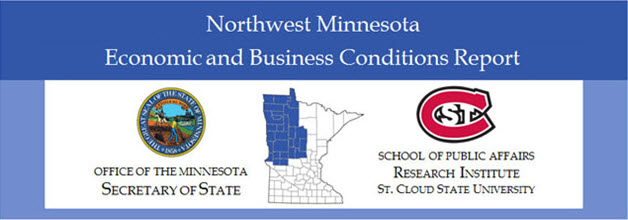Document Type
Research Study
Publication Date
12-20-2016
Abstract
The Northwest Minnesota planning area economy is expected to continue to grow at a pace that is somewhat below normal over the next several months according to the predictions of the St. Cloud State University (SCSU) Northwest Minnesota Index of Leading Economic Indicators (LEI). Two of the five components of the leading index were lower in the third quarter, as the LEI fell by 0.81 points. A declining Rural Mainstreet Index (which signals a more challenging macroeconomic environment for rural America) and weaker consumer sentiment helped drive the index lower. Lower initial jobless claims and rising new filings for incorporation and LLC in the planning area had a favorable impact on the index in the third quarter. A fifth LEI component (residential building permits in Fargo/Moorhead and Grand Forks/East Grand Forks) was largely neutral.
There were 993 new business filings with the Office of the Minnesota Secretary of State in Northwest Minnesota in the third quarter of 2016 — representing a 7.2 percent increase from one year ago. 121 new regional business incorporations were recorded in the most recent quarter, which was 44 percent higher than in the same quarter of 2015. In the third quarter, new LLC filings in Northwest Minnesota were up 8.6 percent from one year earlier—rising to 530. New assumed names totaled 302 in the third quarter—1.9 percent fewer filings than the same period in 2015. There were 40 new filings for Northwest Minnesota non-profits in the third quarter—six fewer filings than one year ago.
Employment of Northwest Minnesota residents declined by 1.8 percent over the year ending September 2016. The regional unemployment rate was 3.6 percent in September, which was higher than the 3.4 percent rate observed one year ago. The Northwest Minnesota labor force contracted over the past twelve months (there are now 4,899 fewer people in the regional labor force than there was one year ago). Initial claims for unemployment insurance in September were essentially unchanged from September 2015. The job vacancy rate in Northwest Minnesota in the second quarter of 2016 remained elevated at nearly 72 per 100 unemployed. The region’s total bankruptcies continue to level out at an historically low level.
Economic performance in the Fargo/Moorhead Metropolitan Statistical Area (MSA) was mostly favorable in the past quarter. This MSA tallied gains in overall employment and in mining, logging and construction employment (but decreased manufacturing employment), lower initial jobless claims, a rise in the regional workforce, increased valuation of residential building permits, a higher average workweek, stronger average hourly earnings, and little change in the relative cost of living. The area did experience an increased unemployment rate, which can be partly explained by a rising labor force. Economic activity in the Grand Forks/East Grand Forks MSA was mixed in the third quarter. Higher overall employment (including an increase in manufacturing employment), a rising labor force, and increased average hourly earnings contributed favorably to regional economic performance. A shorter workweek, a higher unemployment rate, increased initial jobless claims, and a decline in the value of residential building permits all weighed on the Grand Forks/ East Grand Forks outlook.
Recommended Citation
Banaian, King and MacDonald, Richard A., "Northwest Minnesota Economic and Business Conditions Report - Third Quarter 2016" (2016). Northwest Minnesota Economic and Business Conditions Report. 11.
https://repository.stcloudstate.edu/qebcr_nw_mn/11




